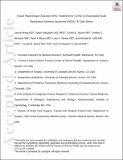| dc.contributor.author | Wang, Janice | |
| dc.contributor.author | Hajizadeh, Negin | |
| dc.contributor.author | Moore, Ernest E. | |
| dc.contributor.author | McIntyre, Robert C. | |
| dc.contributor.author | Moore, Peter K. | |
| dc.contributor.author | Veress, Livia A. | |
| dc.contributor.author | Yaffe, Michael B. | |
| dc.contributor.author | Moore, Hunter B. | |
| dc.contributor.author | Barrett, Christopher D. | |
| dc.date.accessioned | 2020-05-12T19:50:14Z | |
| dc.date.available | 2020-05-12T19:50:14Z | |
| dc.date.issued | 2020-04 | |
| dc.identifier.issn | 1538-7933 | |
| dc.identifier.issn | 1538-7836 | |
| dc.identifier.uri | https://hdl.handle.net/1721.1/125190 | |
| dc.description.abstract | A hallmark of severe COVID-19 is coagulopathy, with 71.4% of patients who die of COVID-19 meeting ISTH criteria for disseminated intravascular coagulation (DIC) while only 0.6% of patients who survive meet these criteria (1). Additionally, it has become clear that this is not a bleeding diathesis but rather a predominantly pro-thrombotic DIC with high venous thromboembolism rates, elevated D-dimer levels, high fibrinogen levels in concert with low anti-thrombin levels, and pulmonary congestion with microvascular thrombosis and occlusion on pathology in addition to mounting experience with high rates of central line thrombosis and vascular occlusive events (e.g. ischemic limbs, strokes, etc.) observed by those who care for critically ill COVID-19 patients (1-7). There is evidence in both animals and humans that fibrinolytic therapy in Acute Lung Injury and ARDS improves survival, which also points to fibrin deposition in the pulmonary microvasculature as a contributory cause of ARDS and would be expected to be seen in patients with ARDS and concomitant diagnoses of DIC on their laboratory values such as what is observed in more than 70% of those who die of COVID-19 (8-10). | en_US |
| dc.language.iso | en | |
| dc.publisher | Wiley | en_US |
| dc.relation.isversionof | http://dx.doi.org/10.1111/jth.14828 | en_US |
| dc.rights | Creative Commons Attribution-Noncommercial-Share Alike | en_US |
| dc.rights.uri | http://creativecommons.org/licenses/by-nc-sa/4.0/ | en_US |
| dc.source | Wiley | en_US |
| dc.title | Tissue plasminogen activator (tPA) treatment for COVID‐19 associated acute respiratory distress syndrome (ARDS): A case series | en_US |
| dc.type | Article | en_US |
| dc.identifier.citation | Wang, Janice et al. "Tissue plasminogen activator (tPA) treatment for COVID‐19 associated acute respiratory distress syndrome (ARDS): A case series." Journal of Thrombosis and Haemostasis (April 2020): 1-4 © 2020 International Society on Thrombosis and Haemostasis | en_US |
| dc.contributor.department | Massachusetts Institute of Technology. Department of Biology | en_US |
| dc.contributor.department | Massachusetts Institute of Technology. Department of Biological Engineering | en_US |
| dc.contributor.department | Koch Institute for Integrative Cancer Research at MIT | en_US |
| dc.relation.journal | Journal of Thrombosis and Haemostasis | en_US |
| dc.eprint.version | Author's final manuscript | en_US |
| dc.type.uri | http://purl.org/eprint/type/JournalArticle | en_US |
| eprint.status | http://purl.org/eprint/status/PeerReviewed | en_US |
| dc.date.updated | 2020-05-12T17:02:18Z | |
| dspace.date.submission | 2020-05-12T17:02:20Z | |
| mit.license | OPEN_ACCESS_POLICY | |
| mit.metadata.status | Complete | |
